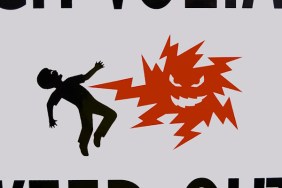You might think you’re on the track to better health but people in Rawa Buaya, Indonesia, have taken “training” to the next level. Villagers there believe if they lie down on the railway tracks, electrical energy carried within the steel rails will end their suffering… that is, if an onrushing train doesn’t do it first.
Fast Track To Good Health?
(image via: Yahoo! News UK)
Illnesses often start with infection by a single pathogenic bacteria or virus which then spreads, er, “virally.” Such is also the case with rumors, and in Indonesia we have a curious, coincidental case of a rumor about a miracle cure spreading virally and expanding into an epidemic of shared beliefs.
(images via: Sahimkamal and Yahoo! News)
It’s known as Railway Therapy or Electric Therapy, and both terms combine to describe the dangerous practice of undergoing various degrees of electrical shocks from contact with railroad tracks.
(images via: Al Jazeera and ABC News)
According to Al Jazeera, who sent on-scene reporter Step Vaessen to Rawa Buaya on the outskirts of Jakarta, Indonesia, to document the odd phenomenon, people of all ages are flocking to nearby railway tracks to get a free hit of electric therapy. Those who have experienced it believe that electricity absorbed from the metal rails can alleviate, even cure, a host of health problems including hypertension, diabetes, rheumatism, gout, obesity and high cholesterol.
Here’s Vaessen’s video report, and kudos to her for risking her health by lying down on the hot rails – pretty much the opposite of the local folks’ intentions.
One wonders what the natives thought about Vaessen “doing like the Romans do”… perhaps it reinforced their distrust of Western medicine. Nice going there, Al Jazeera.
(images via: WSB-FP, The Muslim Times and Planck’s Constant)
How did it all begin? The apocryphal anecdote that sparked (sorry) this frightening fad seems innocent enough: a man from Rawa Buaya (some say he was a taxi driver) had suffered and stroke which left him partially paralyzed. Unable to work and severely depressed after several physicians were unable to improve his condition using conventional treatments, he decided to end it all by lying down on the nearby train tracks.
(images via: Interfaces, The Misir Post and Telegraph UK)
While waiting for the next train to trundle along and end his misery, the man suddenly realized he wasn’t feeling quite so miserable. While versions of the story don’t exactly state the cabbie leaped up and began tap-dancing to his own whistled accompaniment, rumors of the man’s surprising and FREE cure spread like wildfire. Before long, increasing numbers of people began “riding the lightning” in Rawa Buaya, looking for their own lil’ hit of that locomotive ‘lectricity!
Not Your Father’s Electroshock Therapy
(images via: Global Public Square and ImpactLab)
Trains are a popular and ubiquitous form of transportation in Indonesia’s populous urban areas, especially around the capital of Jakarta. Spiderwebs of train tracks spiral out from the city center, linking the inner city with rural and suburban neighborhoods, and often passing through slums where ramshackle housing nestles up to railroad infrastructure. Not only is Railway Therapy free, it’s convenient as well… but does it actually work?
(image via: IB Times)
According to Sri Mulyati it works just fine, thank you, especially when compared to 13 years of ineffective treatments for her diabetes prescribed by expensive doctors. As her body twitched and convulsed with electric current that heralded an approaching train, the 50-year-old Mulyati leaped to safety while stating “I’ll keep doing this until I’m completely cured.”
(images via: Oddity Central, OMG and LINK News)
Besides the aforementioned and largely discredited electroshock treatment, electrical therapy has been known to offer some benefits in the case of certain illnesses. What’s more likely in Indonesia is that people who claim to feel better are at their wit’s end to find effective and affordable cures for their ailments – the trains are their last resort. Call it a placebo effect born of desperation.
(image via: Asiantown)
While rumors of the practice’s beneficial effects continue to spread owing to a critical mass of proponents who report improvements in their condition, at the same time there have been no reports of people adversely affected, either by the electricity or by a wayward train. Judging from the age and infirmity of the people and the nearness of the track switch above, however, we’re guessing the ultimate miracle cure is just one missed signal away.
Engine Near…
(images via: Bossip)
Now just to set the record straight, the Indonesian trains whose tracks are attracting the nation’s tired, poor, huddled masses who yearn to breathe free (among other things) are electrically powered but not in the manner of, say, the New York Subway. That’s why the Rawa Buaya rail-sitters feel mere tingles and not the fatal jolt of the third rail.
(images via: Asiantown and Buffalo News)
No, the power comes from above… not in the way you’re probably thinking, but through overhead cables. Even so, some small fraction of those massive megavolts gets into the rails through the conductive metal bodies, chassis and wheels of the passing trains.
(images via: Hindustan Times and Pro Informasi)
How much power? It depends on many factors: the nearness of the train, the humidity of the air, possibly even the number of people on the tracks getting juiced. The uncertainty involved in the exercise has governmental and corporate authorities worried about being held responsible in case of the inevitable injury(s), which has led to the police posting warning signs at the most popular train therapy locations.
(images via: CTV News and Damn Cool Pictures)
Though threats of penalties of up to three months in prison or fines of $1,800 have reduced the numbers flocking to the railway tracks, people still come and no one has been arrested yet. Times are tough for the state-run railroad company, which can’t afford to secure huge stretches of unguarded track from unwanted visitors.
(images via: Al Jazeera, Jakartad and Telegraph UK
Desperation is the mother of invention, however, and Indonesia’s state-sponsored health system has suffered from severe under-funding over the past dozen years since Suharto, the country’s longtime dictator, was overthrown. “They told us not to do it anymore, but what else can I do?,” explained Hadiwinoto (above, top), who like many Indonesians uses just one name. The 50-year-old has had trouble walking since suffering a debilitating stroke, and his only hope is the glimmering of the steel rails in the hot afternoon sun. “I want to be cured,” said Hadiwinoto, “so I have to come back.” Mr. Conductor, all aboard!!





